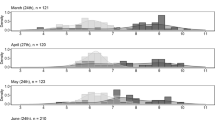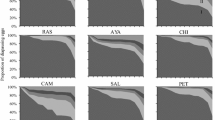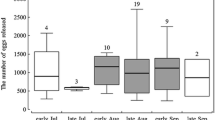Abstract
North American gypsy moths disperse as newly hatched larvae on wind currents in a behavior called ballooning. Because ballooning occurs before neonates begin to feed, resources used in dispersal are limited to those carried over from the egg. We show that nutritional experience of the maternal parent can influence the tendency of offspring to disperse, and that resource provisioning of eggs by the maternal parent affects the duration of the window for disperal. Offspring of females from defoliated sites had a lower tendency to balloon in a wind tunnel than larvae from females which had not experienced nutritional stress associated with host defoliation. The number of eggs in an egg mass, a reflection of the maternal parent's nutritional experience, also contributed to the predictive model for dispersal that included defoliation level. Egg weight and the levels of two yolk proteins, vitellin (Vt) and glycine-rich protein (GRP), however, had no influence of the proportion of ballooning larvae. The length of survival without food, and thus the maximum period of time for dispersal, was correlated with levels of Vt and GRP, but not with egg weight. The level of defoliation at the site from which the maternal parent was collected was not related to the longevity of offspring, nor did it have a significant effect on the levels of Vt, GRP or egg weight. Levels of hemolymph proteins arylphorin and vitellogenin in the maternal parent during the prepupal stage had no influence on levels of yolk proteins, larval longevity, or tendency to balloon.
Similar content being viewed by others
References
Barbosa P, Cranshaw W, Greenblat JA (1981) Influence of food quantity and quality on polymorphic dispersal behaviors inthe gypsy moth, Lymantria dispar. Can J Zool 59:293–296
BMDP Software (1990) Los Angeles, Calif.
Cameron EA, McManus ML, Mason CJ (1979) Dispersal and its impact on the population dynamics of the gypsy moth in the United States of America. Bull Soc Entomol Suisse 52:169–179
Campbell RW (1978) Some effects of gypsy moth density on rate of development, pupation time, and fecundity. Ann Entomol Soc Am 71:442–448
Capinera JL, Barbosa P (1976) Dispersal of first instar gypsy moth larvae in relation to population quality. Oecologia 26:53–64
Capinera JL, Barbosa P (1977) Influence of natural diets and larval density on gypsy moth, Lymantria dispar (Lepidoptera: Orgyiidae), egg mass characteristics. Can Entomol 109:1313–1318
Collins CW (1917) Methods used in determining wind dispersion of the gypsy moth and some other insects. J Econ Entomol 10:170–177
Diss AD (1996) Early larval dispersal of gypsy moth (Lymantria dispar L.): effects of maternal nutrition, provisioning of yolk proteins, and temperature during the egg stage. Ph.D dissertation, Department of Entomology, University of Massachusetts, Amherst, Mass.
Dompenciel RE (1992) Synthesis, storage and utilization of yolk proteins in Lymantria dispar. Ph.D dissertation, Molecular and cellular biology program, University of Massachusetts, Amherst, Mass.
Elkinton JS, Liebhold AM (1990) Population dynamics of gypsy moth in North America. Annu Rev Entomol 35:571–596
Forbush EH, Fernald CH (1896) The gypsy moth. Wright and Potter, Boston, Mass.
Hagadorn HH, Kunkel JG (1979) Vitellogenin and vitellin in insects. Annu Rev Entomol 24:475–505
Hunter AF (1993) Gypsy moth population size and the window of opportunity in spring. Oikos 68:531–538
Hunter AF, Lechowicz MJ (1992) Foliage changes during canopy development of some northern hardwood trees. Oecologia 89:316–323
Karpells ST, Leonard DE, Kunkel JG (1990) Cyclic fluctuations in arylphorin, the principal serum storage protein of Lymantria dispar, indicate multiple roles in development. Insect Biochem 20:73–82
Kunkel J (1988) Analytic immunological techniques. In: Gilbert LI, Miller TA (eds) Immunological techniques in insect biology. Springer, Berlin Heidelberg New York, pp 1–41
Kunkel J, Nordin JH (1985) Yolk proteins. In: Kerkut GA, Gilbert LI (eds) Comprehensive insect physiology, biochemistry and pharmacology, vol 1. Pergamon Press, Oxford, pp 83–111
Lance D, Barbosa P (1981) Host tree influences on the dispersal of first instar gypsy moths, Lymantria dispar (L.). Ecol Entomol 6:411–416
Laurell CB (1966) Quantitative estimation of proteins by electrophoresis in agarose gel containing antibodies. Anal Biochem 15:45–52
Leonard DE (1970) Intrinsic factors causing qualitative changes in population of Porthetria dispar (Lepidoptera: Lymantriidae). Can Entomol 102:239–249
Leonard DE (1971a) Air-borne dispersal of larvae of the gypsy moth and its influence on concepts of control. J Econ Entomol 64:638–641
Leonard DE (1971b) Population quality. In: Toward integrated control. USDA For Ser Res Paper NE-194, pp 7–20
Leonard DE, Kunkel JG (1988) Nutritional ecology: Lymantria dispar as a model system for study of serum storage proteins. In: Wallner WE, McManus KA (eds) Lymantriidae: a comparison of features of new and old world tussock moths. USDA For Ser Gen Tech Rep NE-123, pp 367–380
Liebhold AM, McManus ML (1991) Does larval dispersal cause the expansion of gypsy moth outbreaks? North J Appl For 8:95–98
Mason CJ, McManus ML (1981) Larval dispersal of the gypsy moth. In: Doane CC, McManus ML (eds) The gypsy moth: research toward integrated pest management. US Dept Agric Tech Bull 1584, pp 161–202
McManus ML, Mason CJ (1983) Determination of the settling velocity and its significance to larval dispersal of the gypsy moth (Lepidoptera: Lymantriidae). Environ Entomol 12:270–272
Nichols JO (1961) The gypsy moth in Pennsylvania—its history and eradication. Penn Dept Agric Misc Bull 4404
Rossiter MC (1991) Environmentally-based maternal effects: a hidden force in insect population dynamics? Oecologia 87:288–294
Rossiter MC (1992) The impact of resource variation on population quality in herbivorous insects: a critical aspect of population dynamics. In: Hunter MD, Ohgushi T, Price PW (eds) Effects of resource distribution on animal-plant interactions. Academic Press, San Diego, pp 13–42
Rossiter MC, Schultz JC, Baldwin IT (1988) Relationships among defoliation, red oak phenolics, and gypsy moth growth and reproduction. Ecology 69:267–277
Slansky F, Rodriguez JG (1987) Nutritional ecology of insects, mites, spiders, and related invertebrates: an overview. In: Slansky F, Rodriguez JG (eds) Nutritional ecology of insects, mites, spiders, and related invertebrates. Wiley, New York, pp 1–71
Author information
Authors and Affiliations
Rights and permissions
About this article
Cite this article
Diss, A.L., Kunkel, J.G., Montgomery, M.E. et al. Effects of maternal nutrition and egg provisioning on parameters of larval hatch, survival and dispersal in the gypsy moth, Lymantria dispar L.. Oecologia 106, 470–477 (1996). https://doi.org/10.1007/BF00329704
Received:
Accepted:
Issue Date:
DOI: https://doi.org/10.1007/BF00329704




